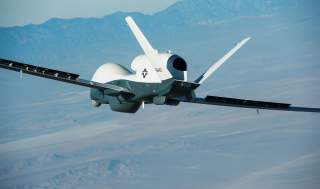Drones Are a Threat—but Not for the Reason You Think
Bad for deterrence and stability?
Key point: As weak targets, drones increase the chance of escalation and miscalculation.
The proliferation of robotic warships could make naval warfare safer for human beings. But it also could have the unintended effect of reducing the threshold for military action.
Recent events in the Strait of Hormuz underscore that danger. In the summer of 2019 U.S. and Iranian forces each shot down a surveillance drone belonging to the other side, escalating tensions that began with U.S. president Donald Trump’s decision to withdraw the United States from the 2015 deal limiting Iran’s nuclear program.
“The immediate danger from militarized artificial intelligence isn't hordes of killer robots, nor the exponential pace of a new arms race,” Evan Karlik, a U.S. Navy lieutenant commander, wrote for Nikkei Asian Review.
“As recent events in the Strait of Hormuz indicate, the bigger risk is the fact that autonomous military craft make for tempting targets -- and increase the potential for miscalculation on and above the high seas,” Karlik wrote.
While less provocative than planes, vehicles, or ships with human crew or troops aboard, unmanned systems are also perceived as relatively expendable. Danger arises when they lower the threshold for military action.
If China dispatched a billion-dollar U.S. destroyer and a portion of its crew to the bottom of the Taiwan Strait, a war declaration from Washington and mobilization to the region would undoubtedly follow. But should a Chinese missile suddenly destroy an orbiting, billion-dollar U.S. intelligence satellite, the White House and the U.S. Congress might opt to avoid immediate escalation.
"Satellites have no mothers," quip space policy experts, and the same is true for airborne drones and unmanned ships. Their demise does not call for pallbearers, headstones or memorial statues.
As autonomous systems proliferate in the air and on the ocean, military commanders may feel emboldened to strike these platforms, expecting lower repercussions by avoiding the loss of human life.
Consider when Chinese naval personnel in a small boat seized an unmanned American underwater survey glider in the sea approximately 100 kilometers [or 6.2 miles] off The Philippines in December 2016.
The winged, torpedo-shaped unit was within sight of its handlers aboard the U.S. Navy oceanographic vessel Bowditch, who gaped in astonishment as it was summarily hoisted aboard a Chinese warship less than a kilometer distant.
The U.S. responded with a diplomatic demarche and congressional opprobrium, and the glider was returned within the week.
Opportunities for robot-seizures in coming years could increase. The U.S. Navy between 2020 and 2024 wants to spend around $4 billion buying 10 large unmanned surface vessels and nine unmanned submarines. Robotic ships would account for a quarter of shipbuilding starts over the five-year period.
The unmanned vessels could help the Navy to grow the fleet despite proposed cuts and slowdowns in the acquisition of traditional manned vessels. A Chinese company in early 2019 revealed its own robotic warship design.
“China's navy may find intercepting such unmanned and unchaperoned surface vessels or mini-submarines too tantalizing to pass up, especially if Washington's meek retort to the 2016 glider incident is seen as an indication of American permissiveness or timidity,” Karlik wrote.
With a captive vessel, persevering Chinese technicians could attempt to bypass anti-tamper mechanisms, and if successful, proceed to siphon off communication codes or proprietary artificial intelligence software, download navigational data or pre-programmed rules of engagement, or probe for cyber vulnerabilities that could be exploited against similar vehicles.
No doubt Beijing is closely watching how the Trump administration responds to Iran's downing of a Global Hawk surveillance drone on June 20, [2019], assessing U.S. willingness to punch back in kind, or to escalate.
“Urgent action is needed,” Karlik opined.
“A memorandum of understanding signed five years ago by the U.S. Department of Defense and the Chinese defense ministry, as well as the collaborative code of naval conduct created at the 2014 Western Pacific Naval Symposium, should be updated with an expanded right-of-way hierarchy and non-interference standards to clarify how manned ships and aircraft should interact with their autonomous counterparts,” he wrote.
“Without such guidance, the risk of miscalculation increases.”
David Axe serves as Defense Editor of the National Interest. He is the author of the graphic novels War Fix, War Is Boring and Machete Squad. This first appeared in July 2019.
Image: Reuters

